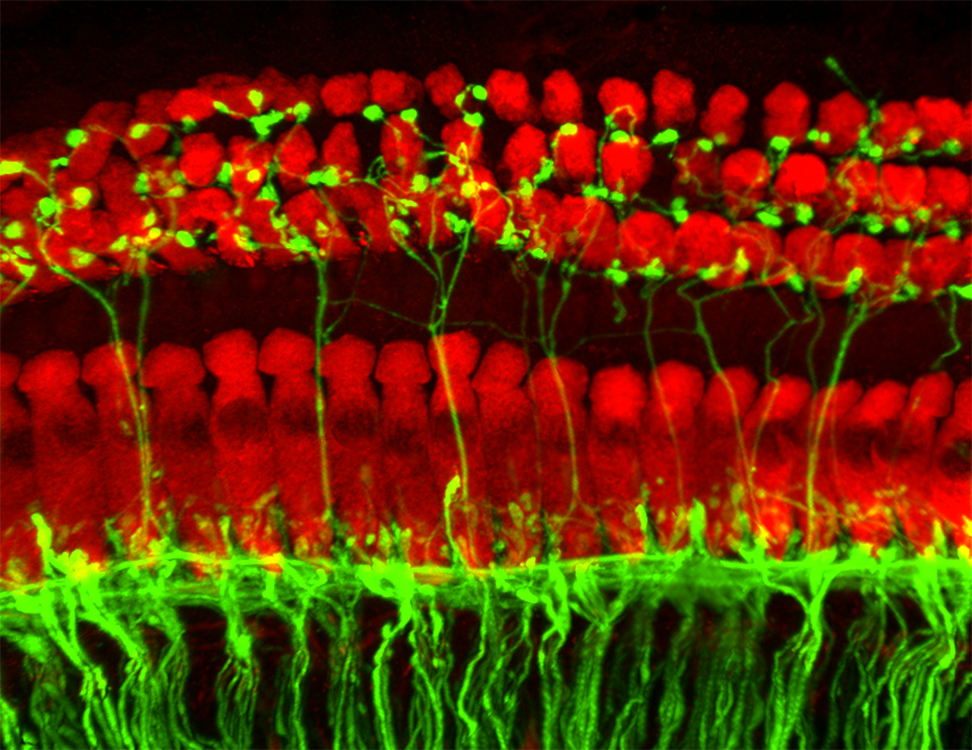Tinnitus, the buzzing, humming or ringing sounds perceived in the ears or head – can be as quiet as a whisper one minute or as loud as a jackhammer the next. For some people these phantom sounds can range from whooshing noises to train whistles, cricket noises or whines. Severity can vary from day to day.
Tinnitus afflicts about 50 million people in the United States and is the leading form of disability affecting women and men in uniform — more than 12 percent of American troops returning home have been exposed to acoustic trauma from machinery or blast-induced tinnitus from explosive devices.
Patients with tinnitus have been shown to process emotions differently in the brain from people with normal hearing, and studies show that tinnitus is often linked with increased stress, anxiety, irritability and depression.
“About 2 to 4 percent are debilitated by their tinnitus so it rules their life, and some have said that they lost their job, their spouse,” says Michael D. Seidman, M.D., director of the Division of Otologic/Neurotologic Surgery in the Department of Otolaryngology-Head & Neck Surgery at Henry Ford Hospital.
Tinnitus and the Glutamate Storm
When the ears are exposed to loud noise or infections, the tiny hair cells that transmit sounds to the brain (stained red in image above) become stressed and start to emit excess quantities of glutamate, a type of chemical messenger known as a neurotransmitter.
Called a ‘glutamate storm,’ this over-stimulates nerve cells in the inner ear to the point where they eventually die.
These nerve cells have the job of sending sound impulses up to the auditory cortex, the part of the brain that processes noise. When the nerve cells in the inner ear die, it leaves nerve cells in the auditory cortex in a permanently switched-on state, where they constantly relay sound to the brain, even when there is no incoming signal from the ear.
By this point, the tinnitus is no longer being caused by the damaged ear cells but is rooted in the brain itself.
Conditions known to trigger or worsen tinnitus include:
- Exposure to loud noises
- Hearing loss
- Tumors of the hearing/balance nerve
- Ear or sinus infections
- Head and neck trauma
- Medical disorders such as hypo- or hyperthyroidism, Lyme disease, fibromyalgia and thoracic outlet syndrome.
While there is no cure for tinnitus, ongoing research is showing promise for new treatment options to aid patients in managing and/or reducing symptoms. Two approaches currently undergoing clinical trials include:
• Vagal Nerve Stimulation, in which a small device surgically implanted under the skin uses electrical impulses to send signals along the vagus nerve to the brainstem. Scientists have combined vagus nerve stimulation with playing audible tones to decrease the symptoms of tinnitus. VNS-tone therapy has been shown to significantly reduced symptoms in 4/10 patients with effects lasting for more than two months.
• AM-101, a gel injection that may lessen the excessive signaling to the brain that occurs with tinnitus. The gel is injected through the eardrum three times over a period of five days. The gel targets a receptor on nerve cells that allows glutamate to get in. Researchers hope that blocking the receptor will prevent glutamate from binding to the nerve cell and causing damage, giving the damaged nerve cells a chance to regrow before tinnitus can set in for good.
In a small study published in the journal Otology and Neurotology researchers at Antwerp University Hospital, Belgium, treated 248 patients with either the real gel or a placebo. Forty-two per cent of patients in the treatment group reported that their tinnitus symptoms were reduced by half, compared with only 14 per cent in the placebo group. After 90 days, 57 per cent of those taking the active gel said their tinnitus was ‘much improved’ or ‘very much improved’.
So far the AM-101 treatment is only suitable for people who have had tinnitus for less than a year and in cases where the onset can be attributed to a specific cause, such as a loud blast of sound or an ear infection.
Researchers are also working with a non-invasive imaging technique called magnetoencephalography (MEG) to help pinpoint the sites in the brain where tinnitus is perceived. The hope is that MEG will allow physicians to target these area with electrical or chemical therapies to lessen symptoms.
Sources:
- Jake R. Carpenter-Thompson, Kwaku Akrofi, Sara A. Schmidt, Florin Dolcos, Fatima T. Husain. Alterations of the emotional processing system may underlie preserved rapid reaction time in tinnitus. Brain Research, 2014; 1567: 28 DOI: 10.1016/j.brainres.2014.04.024
- Dirk De Ridder, Sven Vanneste, Navzer D. Engineer, Michael P. Kilgard. Safety and Efficacy of Vagus Nerve Stimulation Paired With Tones for the Treatment of Tinnitus: A Case Series. Neuromodulation: Technology at the Neural Interface, 2013; DOI: 10.1111/ner.12127













[…] treatment that is being tested is known as AM-101. This is a gel injection that is administered three times over a period of five days. The results […]